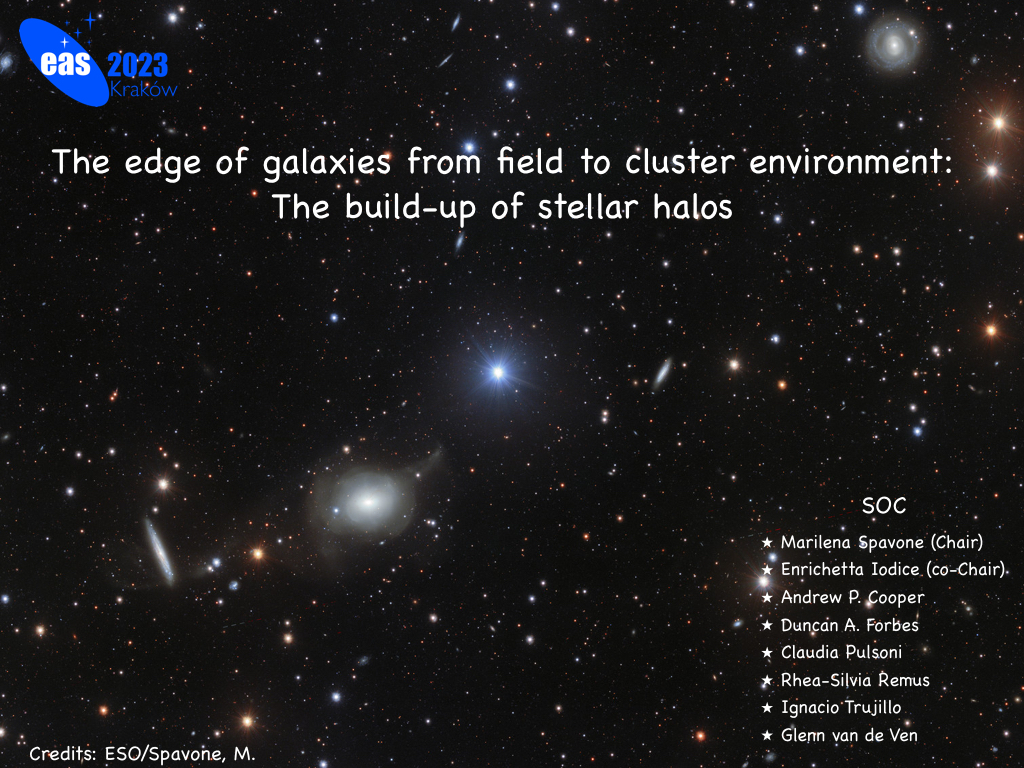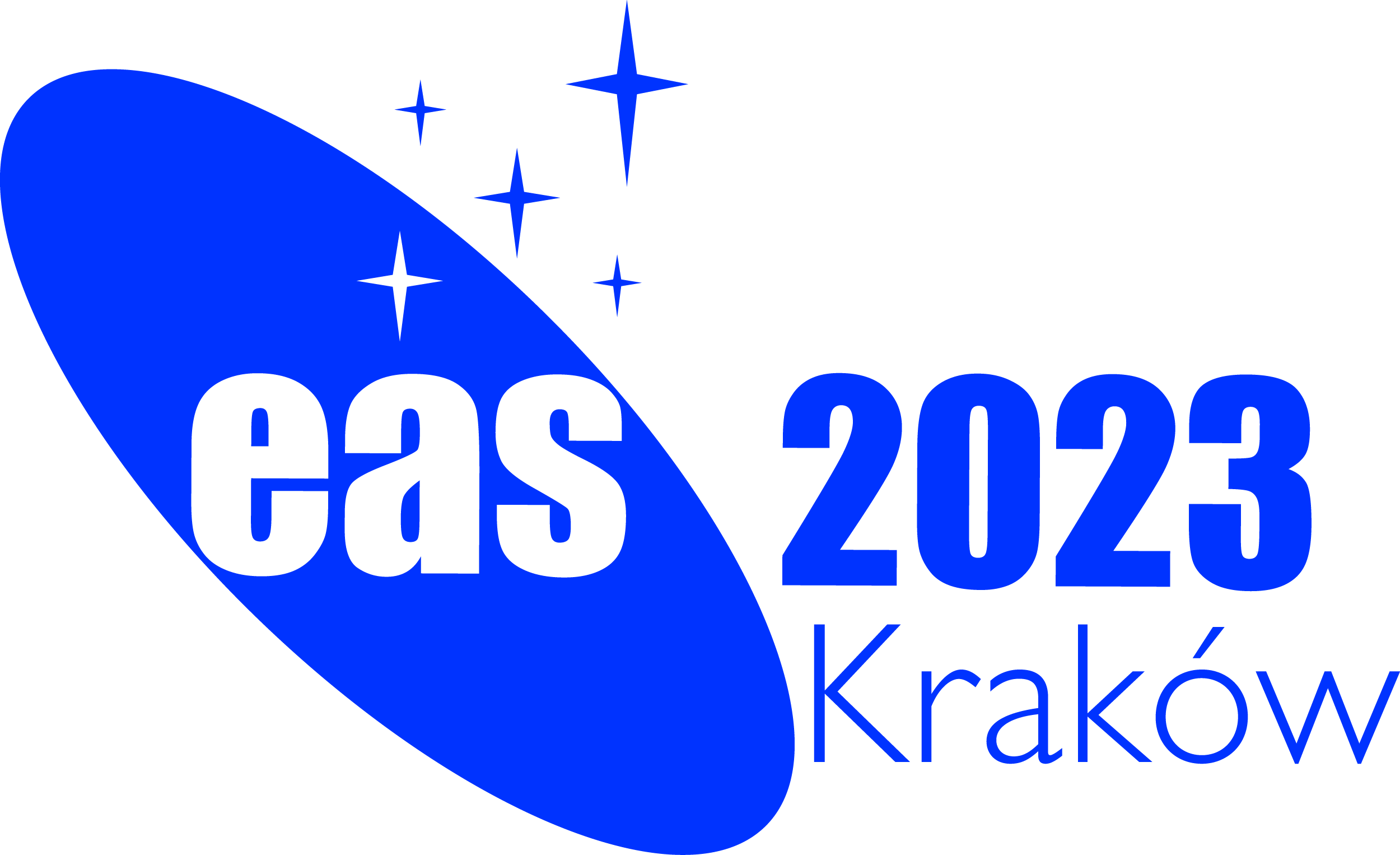Special Session SS10
14 July 2023
The edge of galaxies from field to cluster environment: the build-up of stellar halos

Aims and scope
From both the observational and theoretical side, it is broadly accepted that the stellar masses of the present day massive galaxies result from the gradual accretion of satellites, forming especially the extended outer stellar halos. Accreted stars are expected to dominate in the outer parts of galaxies because they have much lower binding energies in the remnant system than stars formed by dissipative collapse. Since dynamical timescales are long in these outer regions, phase-space substructures related to accretion processes, can persist over many gigayears. The structural properties of the outer parts of galaxies and their correlations with stellar mass and other observables therefore provide ways of testing theoretical predictions of growth by accretion and decipher the observed galaxies formation pathways. For example, they could constrain the overall ratio of stars accreted to those formed in situ, the number of significant progenitors, and the dynamics of the most important merger events.
Observations of diffuse starlight in the outskirts of galaxies are thought to be a fundamental source of constraint on the cosmological context of galaxy assembly in the ?CDM model. However, such observations are not trivial because of the extreme faintness of such regions. Therefore, the comparison between the photometric and spectroscopic observables and the theoretical predictions has not provided a general consensus yet.
Both N-body and hydrodynamical simulations predict that the amount of accreted mass (i.e., the ex-situ component) is a function of the total stellar mass of a galaxy, with the higher mass galaxies having an higher accreted mass fraction. Furthermore, the surface-brightness and metallicity radial profiles appear flatter in the galaxy outskirts when repeated mergers occur, suggesting that the accreted fraction of metal-rich stars increases. Some simulations also predict that the radius marking the kinematic transition between different galaxy components provides a good estimate of the transition radius between the in-situ and accreted component, while some other found the opposite.
Deep photometric and spectroscopic surveys have a pivotal role in the study of stellar halos. To date, many observational studies have identified features in the surface brightness profiles, kinematic distributions and stellar populations, that are indicative of substructure in the accreted component. In the near future such studies will be further fostered by the upcoming wide-field facilities for imaging and spectroscopic surveys (VRO, Roman, and so on).
Programme
This meeting aims to put together a comprehensive overview of our understanding about galaxy stellar outskirts and stellar halos, bringing together simulators and observers, to address the main open issues.
The subject is interesting for a large community, since many meetings and papers are being doing to discuss all these issues. This is excellent timing for this symposium, given that there is a renaissance of the low surface brightness studies due to new facilities and reduction algorithms and much progress is foreseen in the near future.
In detail, the meeting will focus on the following points:
- What are the main mechanisms for the origin, assembly, and dynamical evolution of the stellar halos?
- Is there a way to separate the in-situ component from stellar halos, both from observational and theoretical sides?
- Is there a physical boundary between galaxies, their stellar halos and the Intracluster Light?
- How can we deal with the main issues of the detection of low surface brightness features (extended PSFs, Galactic cirrus, and so on)?
- What can tracers populations of the faint outskirts like Globular Clusters and Planetary Nebulae tell us about the stellar halos and their assembly?
- Can we constrain merging timescales from the presence of different structures like streams and shells? Does that differ between environments?
- Can the Intracluster Light trace the dynamical status of a cluster?
- Which information is encoded in the different tracers? Do they agree? Do they provide complementary information, or do we really need them all?
Invited speakers
- Johanna Hartke (Turku University, Finland)
- Lucas Kimmig (Ludwig-Maximilians University, Munich)
- Mireia Montes (Instituto de AstrofŪsica de Canarias, Tenerife)
Scientific organisers
- Marilena Spavone (INAF Naples, Italy), Chair
- Enrichetta Iodice (INAF Naples, Italy), co-Chair
- Andrew P. Cooper (National Tsing Hua University, Taiwan)
- Duncan A. Forbes (Swinburne University, Australia)
- Claudia Pulsoni (Max Planck Institute for Extraterrestrial Physics, Germany)
- Rhea-Silvia Remus (Ludwig-Maximilians-Universitšt, Germany)
- Ignacio Trujillo (IAC, Spain)
- Glenn van de Ven (University of Vienna, Austria)
Contact
Marilena Spavone: marilena.spavone @ inaf.it
Updated on Fri Jan 13 15:01:21 CET 2023
|

 A power cut will shut down all EAS services on Tuesday, 10 January 2017 starting at 7:30 CET.
A power cut will shut down all EAS services on Tuesday, 10 January 2017 starting at 7:30 CET.


